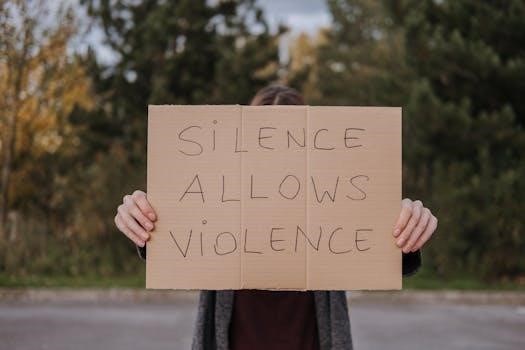Vice and Violence PDF⁚ An Overview
The convergence of “vice” and “violence” often manifests in complex scenarios‚ explored through various mediums like role-playing games‚ academic studies‚ and literature. A PDF overview would likely delve into the intersectionality of these themes‚ examining their historical context and social implications.
The exploration of “vice and violence” presents a multifaceted examination of human behavior‚ societal structures‚ and the complex interplay between morality and transgression. This introduction aims to provide a foundational understanding of these intertwined concepts‚ setting the stage for a deeper dive into their definitions‚ historical contexts‚ and psychological underpinnings. By examining various perspectives‚ including those found in literature‚ role-playing games‚ and academic research‚ we can gain a comprehensive grasp of how vice and violence manifest in diverse settings.
This analysis will delve into the motivations behind these behaviors‚ the societal factors that contribute to their prevalence‚ and the consequences they inflict on individuals and communities. We will also explore the ethical considerations surrounding vice and violence‚ examining how different cultures and legal systems grapple with these issues. Ultimately‚ this introduction seeks to establish a framework for understanding the multifaceted nature of vice and violence‚ paving the way for a more nuanced and informed discussion.

Understanding Vice
To truly understand “vice‚” we must explore its conceptual frameworks‚ historical perspectives‚ and its psychological roots. Examining these facets provides a comprehensive understanding of the complex nature of vice and its impact.
Defining Vice⁚ A Conceptual Framework
Defining vice requires navigating a complex landscape of morality‚ ethics‚ and societal norms. Conceptually‚ vice often refers to behaviors‚ habits‚ or activities considered immoral‚ sinful‚ or detrimental to individual character or social well-being.
Philosophical perspectives‚ such as those offered by Bernard Hollander‚ M.D.‚ explore the psychology of misconduct‚ vice‚ and crime‚ providing insights into the motivations and underlying factors driving these behaviors. Examining historical attitudes towards vice crimes‚ as seen in late nineteenth and early twentieth-century legislation‚ reveals evolving societal values and concerns.
Furthermore‚ understanding the distinction between vice and crime‚ where crime involves a plan or intent to injure‚ helps clarify the scope and nature of vices. This conceptual framework allows for a nuanced analysis of the role of vice in broader societal contexts.
Historical Perspectives on Vice Crimes
Examining historical perspectives on vice crimes provides a crucial understanding of how societies have defined and responded to behaviors deemed immoral or harmful. Legislation from the late nineteenth and early twentieth centuries offers insights into the evolving societal values and concerns surrounding vice.
Historically‚ activities such as prostitution‚ gambling‚ and drug use have often been categorized as vice crimes‚ reflecting moral and ethical judgments of the time. The regulation and prohibition of these activities have varied across cultures and time periods‚ influenced by religious beliefs‚ social norms‚ and political considerations.
Furthermore‚ historical analysis reveals the intersection of vice with other social issues‚ such as poverty‚ disease‚ and violence. For example‚ the historical context of prostitution often involved women facing limited economic opportunities and the threat of violence and disease. Studying these historical perspectives allows for a nuanced understanding of the complex relationship between vice‚ society‚ and the law.

Exploring Violence
Violence‚ distinct from vice‚ involves intentional harm. Exploring violence requires understanding its psychological underpinnings‚ societal factors‚ and manifestations. Examining violence as a vice of consent offers a further layer of ethical consideration.
The Psychology of Misconduct‚ Vice‚ and Crime
Delving into the psychology of misconduct‚ vice‚ and crime requires an understanding of the motivations and thought processes behind these behaviors. Factors such as societal influences‚ personal experiences‚ and mental health can significantly contribute to an individual’s propensity towards vice or violence. Examining the intent behind actions is crucial‚ distinguishing between impulsive acts and premeditated offenses.
Furthermore‚ the psychology explores how individuals rationalize their behaviors‚ often employing cognitive distortions to justify actions considered immoral or illegal. Studying the psychological aspects of misconduct offers insights into the underlying causes of vice and crime‚ aiding in the development of effective prevention and intervention strategies. By recognizing the influence of psychological vulnerabilities‚ we can better understand the complexities of human behavior and the paths that lead to transgression‚ focusing on rehabilitation and societal safety through a nuanced understanding of the human mind.
Violence as a Vice of Consent
The concept of “violence as a vice of consent” introduces a complex and ethically challenging dimension to the study of vice and violence. This explores scenarios where individuals willingly engage in violent acts‚ blurring the lines between consensual activity and harmful behavior. The psychology behind such consent often involves power dynamics‚ personal desires‚ and the exploration of boundaries.
Understanding this phenomenon requires examining the motivations of all parties involved‚ considering factors such as trauma‚ societal influences‚ and individual autonomy. It raises questions about the limits of consent and the potential for exploitation within seemingly consensual frameworks. Further research into the psychological and social factors that contribute to violence as a vice of consent is essential for informing ethical discussions and developing responsible policies. Recognizing the nuanced nature of consent is crucial when addressing the complex interplay between vice and violence‚ ensuring individual rights and societal well-being are upheld.

Vice & Violence as a Role-Playing Game (RPG)
The Vice & Violence RPG explores mature themes‚ offering players a unique gaming experience. It delves into darker settings‚ diverging from typical RPGs. Character creation and gameplay mechanics reflect these mature elements.
Vice & Violence by Rapscallion Games
Rapscallion Games has developed “Vice & Violence‚” a role-playing game that distinguishes itself through its exploration of mature and often explicit themes. This adult RPG is not a typical fantasy adventure but rather a delve into the darker aspects of human behavior and societal issues.
The game’s content is explicitly NSFW (Not Safe For Work)‚ indicating that it contains material unsuitable for minors or those sensitive to adult topics. Players can expect to encounter scenarios involving vice‚ violence‚ and themes of consent‚ challenging them to navigate complex moral dilemmas within the game world.
Rapscallion Games provides various resources for players‚ including a core rulebook‚ character creation guides‚ and virtual aids for online play. These materials are often distributed in PDF format‚ allowing for easy access and sharing among players. The game has garnered a dedicated following‚ with fans engaging through platforms like Patreon and Discord to share their experiences and creations.
Character Creation in Vice & Violence (PDF Materials)
Character creation in “Vice & Violence‚” the RPG by Rapscallion Games‚ is a crucial step in immersing players in its mature and gritty world. To facilitate this process‚ Rapscallion Games offers PDF materials specifically designed for character generation‚ ensuring a seamless and comprehensive experience.
These PDF guides provide players with detailed instructions on crafting their characters‚ including defining their backgrounds‚ skills‚ and moral compass. Given the NSFW nature of the game‚ character creation also involves considering the characters’ involvement in vice and their capacity for violence‚ shaping their roles within the game’s morally ambiguous landscape.
The PDF format allows for easy distribution and accessibility‚ enabling players to create their characters conveniently‚ whether playing in person or online. These character sheets often include spaces for tracking various stats and attributes‚ helping players manage their characters effectively throughout the game. These materials reflect the game’s focus on exploring complex themes‚ ensuring that character creation is a thoughtful and engaging process.
The NSFW Nature of Vice & Violence
“Vice & Violence‚” the RPG by Rapscallion Games‚ is explicitly designed for mature audiences due to its “Not Safe For Work” (NSFW) nature. This designation indicates that the game delves into themes and scenarios that are unsuitable for minors or those who may be sensitive to adult content.
The game explores mature themes‚ which may include depictions of violence‚ sexual content‚ and morally ambiguous situations. Players should be aware of these elements before engaging with the game. The creators emphasize the importance of player comfort and consent‚ encouraging groups to discuss boundaries and tolerances before playing.
The game’s NSFW nature is integral to its exploration of complex themes and its distinct identity within the RPG landscape. While the game is not for everyone‚ it offers a unique experience for those interested in delving into mature narratives and challenging moral questions. It’s crucial for potential players to understand the game’s content and ensure it aligns with their comfort levels.

Related Themes
Exploring vice and violence inevitably leads to related themes such as sexual violence policies‚ and the intersection of vice‚ violence‚ and disease. These interconnected issues provide a broader understanding of the complexities involved.
Sexual Violence Policies
Examining sexual violence policies in the context of “vice and violence” necessitates a comprehensive understanding of institutional responses and preventative measures. Universities and organizations are increasingly developing frameworks to address harassment‚ hate‚ and sexual misconduct‚ often guided by expert panels and recommendations. These policies aim to create safer environments by establishing clear reporting procedures‚ support systems for survivors‚ and disciplinary actions for perpetrators.
The implementation of such policies involves navigating complex legal and ethical considerations. Expert knowledge is crucial in shaping effective strategies that promote accountability and foster a culture of respect. Furthermore‚ ongoing evaluation and adaptation of these policies are essential to ensure their continued relevance and efficacy in addressing the evolving challenges related to sexual violence. The ultimate goal is to prevent harm and provide justice for those affected by these egregious acts.
The Intersection of Vice‚ Violence‚ and Disease
The convergence of vice‚ violence‚ and disease presents a multifaceted challenge with deep historical roots; Historically‚ marginalized communities and those engaged in activities deemed “vices” often faced increased vulnerability to both violence and disease. Factors such as poverty‚ lack of access to healthcare‚ and social stigma exacerbated these risks‚ creating a vicious cycle of vulnerability.
Examining this intersection requires a nuanced understanding of the social determinants of health and the ways in which vice-related behaviors can increase exposure to violence and infectious diseases. For example‚ prostitution has historically been linked to both violence against women and the spread of sexually transmitted infections. Addressing these issues necessitates comprehensive public health interventions that target the underlying social and economic factors that contribute to vulnerability. These interventions must be coupled with efforts to reduce stigma and promote access to healthcare services for all individuals‚ regardless of their involvement in vice activities.
In conclusion‚ the exploration of vice and violence‚ particularly through mediums like the Vice & Violence RPG and academic analyses‚ reveals a complex interplay of human behaviors‚ societal norms‚ and individual choices. Examining these themes through a PDF format allows for a comprehensive and accessible resource for understanding the nuances and implications of actions deemed deviant or harmful.
Whether considering historical perspectives‚ the psychological underpinnings of misconduct‚ or the intersection of vice with related themes such as disease and sexual violence policies‚ it becomes clear that a multifaceted approach is necessary. Understanding these elements allows for a greater grasp on the human condition‚ its flaws‚ and the potential for both destruction and redemption that lies within us all. Further study and open dialogue are essential to address the challenges and complexities presented by the convergence of vice and violence in society.

